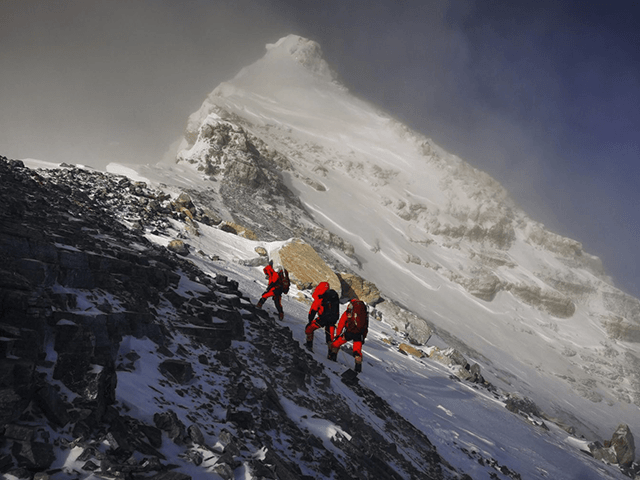The government of Nepal announced on Thursday that everyone who climbs Mount Everest will henceforth be required to carry a GPS tracking chip to assist with rescue and recovery efforts.
“Reputed companies were already using them but now it’s been mandatory for all climbers. It will cut down search and rescue time in the event of an accident,” Nepalese tourism director Rakesh Gurung told CNN.
The tracking chips will essentially be rented for $10 to $15, a minimal fee given that climbing Everest costs around $40,000 for equipment, supplies, permits, and guides. Mountaineers must agree to sew the tracking chips into their clothing for the duration of the climb, which can take up to two months, and return the chips.
CNN noted that an increasing number of people are attempting to climb Everest, which means a growing number of accidents and rescues. The year 2023 was a record for Nepal with 478 climbers obtaining permits. Of those, 17 of them either died or went missing during the climb, making 2023 the deadliest year in Everest’s recorded history.
“It is almost impossible to rescue climbers at that altitude,” an official with the Nepalese tourism department pointed out on Friday.
National Geographic described Everest as a “mess” and an “icon for everything that is wrong with climbing” due to overcrowding. It is possible to complete the arduous and still dangerous climb only to find that there is no room left to stand on the peak because dozens of people are already there. The two most commonly used routes to the summit are festooned with garbage discarded by climbing groups.
National Geographic noted:
Today, roughly 90 percent of the climbers on Everest are guided clients, many without basic climbing skills. Having paid $30,000 to $120,000 to be on the mountain, too many callowly expect to reach the summit. A significant number do, but under appalling conditions.
The Economist noted in 2020 that more of Everest’s climbers are inexperienced and more of them are elderly, as well. The odds of an over-60 climber reaching the summit have risen to roughly one in three over the past 20 years, and a little more than 20 percent for those over 70.
Another reason for requiring GPS tracking chips on all climbers is to prevent cheating. On Friday, the Kathmandu Post reported the Nepalese tourism ministry recommended that the Everest climbing certificates of two Indian nationals be revoked because they provided fake documents and faked photos of themselves standing at the summit.
Nepal has traditionally required climbers to submit a photo of themselves at the peak to obtain an Everest climbing certificate, backed up by documents from a liaison officer who usually stays at the climbers’ base camp. The liaison officers are well-compensated civil servants who are sometimes agreeable to falsifying their reports to become even more well-compensated, and computer technology has advanced to the point where photos of successful climbs are not difficult to falsify, so GPS data could become the new gold standard for verified ascents.
The Nepalese tourism ministry may also require biometric attendance systems to ensure that climbers and liaison officers ascend to the base camps.
“This is an effective way to prevent liaison officers from colluding with hoax climbers. It will depend on the department guidelines whether liaison officers have to make attendance on a daily basis once they reach the Everest base camp,” said Tourism Ministry engineer Pradip Raj Poudel.

COMMENTS
Please let us know if you're having issues with commenting.